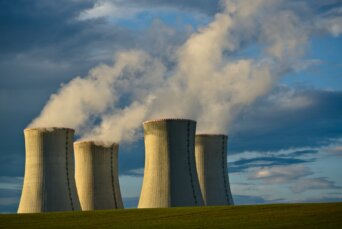- About
- Topics
- Picks
- Audio
- Story
- In-Depth
- Opinion
- News
- Donate
-
Signup for our newsletterOur Editors' Best Picks.Send
Read, Debate: Engage.

| topic: | Divestment |
|---|---|
| editor: | Abby Klinkenberg |
The ongoing global energy crisis that has inspired spikes in gas and electricity prices worldwide has revived a number of conversations in the European Union about how to best achieve its goal of carbon neutrality by 2050. Among them, the issue of nuclear power is perhaps the most divisive, splitting the EU’s 27 member states along fierce geopolitical lines.
On 11 October, ten EU member states led by France expressed their joint support for including nuclear power in the EU’s “taxonomy on sustainable financing,” which would essentially allow the EU to support nuclear projects under its green financing initiative. Despite heavy historical baggage, nuclear power is a clean, zero-emissions energy source that in 2020 generated 25 percent of the EU’s total energy mix. France, an ardent supporter of nuclear power, drew 70 percent of its energy from nuclear sources last year, while the Czech Republic relied on its six nuclear reactors for 37 percent of its energy.
The issue of nuclear power pits two of the EU’s largest political and economic players against one another: France has long pursued a robust energy policy firmly in support of nuclear power while Germany has cemented for itself a firmly anti-nuclear stance. Earlier this month, President Emmanuel Macron doubled down on France’s nuclear strategy, announcing a new €1 billion investment in new-generation nuclear reactors. On the other hand, 2022 will witness the shutdown of the last of Germany’s nuclear reactors, completing Chancellor Angela Merkel’s 2011 plan to phase out the country’s 17 nuclear power plants in the wake of the Fukushima disaster.
As these two European powerhouses move in distinctly different directions, the rest of the EU is compelled to take sides - notably, member states’ positions seem to be largely split along West/East lines.
With the exception of France, the vast majority of countries in support of including nuclear energy in the EU’s green taxonomy are former communist nations that still find themselves partly in Russia’s sphere of influence: Czech Republic, Finland, Poland, Hungary, Slovakia, Bulgaria, Croatia, Romania and Slovenia. Compared to the richer Western European countries that have largely eschewed nuclear power, these member states are desperate for a transitional source to accelerate their move away from coal and towards a greener future. These countries’ desire for greater energy independence is also understandable, especially as Russia consolidates its provision of natural gas to the EU via the Nord Stream 2 pipeline.
Germany, Denmark, Austria, Luxembourg and Spain constitute the bloc’s most vehement opposition and insist that nuclear power cannot be a viable path towards a sustainable future given the extensive and messy issues relating to the disposal of radioactive waste, as well as the dangerous, costly and slow process of constructing nuclear power plants.
The current energy crisis and growing political pressure to curb carbon emissions have prompted discussions about the viability of nuclear power as part of the EU’s move towards carbon neutrality, begging the question of whether all EU member states should follow the same path towards sustainability. Does a one-size-fits-all solution make sense?
On 21 October, a majority of the 27 EU member states voted in favour of including natural gas and nuclear energy in the EU’s environmental taxonomy. The EU’s Financial Services Commission, however, has punted the issue further down the line, declaring that a decision will be made as to whether nuclear energy would be eligible for green financing towards the end of 2021.
Significantly, France will take over as president of the Council of the European Union, which could likely tip the regulatory balance in a pro-nuclear direction.
Photo by Lukáš Lehotský
